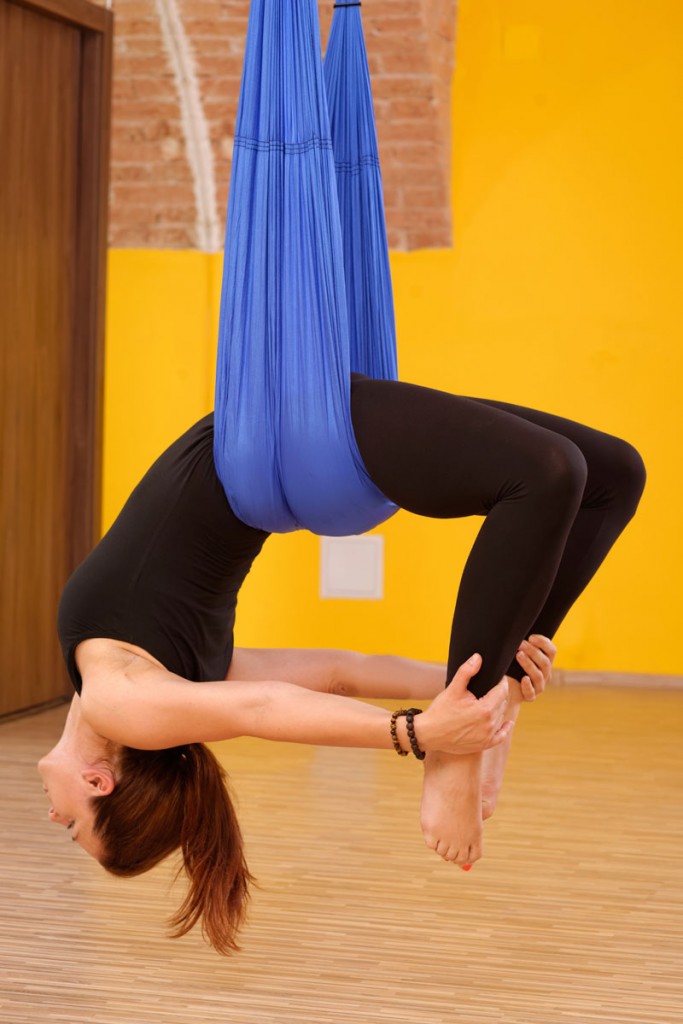Aerial Yoga—Turning Yoga Upside Down
By Rachelle Stoller
June 2014 View more Health & Fitness
 Move over hot yoga, there’s a new asana in town. Aerial yoga is taking the health and wellness world by storm and making yoga practice possible for nearly everyone, from novices, to people recovering from injury, to the most experienced yogis.
Move over hot yoga, there’s a new asana in town. Aerial yoga is taking the health and wellness world by storm and making yoga practice possible for nearly everyone, from novices, to people recovering from injury, to the most experienced yogis.
What Is Aerial Yoga?
Take traditional yoga, where students move through a series of postures, and add a “spotter” of sorts in the form of a suspended fabric hammock that hangs close to the ground. The hammock helps participants achieve correct form and promotes flexibility. Seasoned yogis can get deeper into stretches, while novices and students with various injuries use the hammocks for support as they get into poses, according to Kristin McNabb of Tease Dance and Fitness in Aurora.
“We have so many students who suffer from knee and back issues. Aerial yoga allows them to move past their bodies’ physical limitations without putting pressure on their backs and joints,” said McNabb.
She also points out that the hammocks are especially relaxing when students do savasanas or relaxation poses.
“Some of our students even come into the studio during lunch time, lie in the hammock and follow a guided meditation to help them relax,” said McNabb.
Yoga For Everyone (Almost)
Because each hammock can support up to 2,000 pounds, almost anyone of any age can take an aerial yoga class. It is an ideal exercise for the following:
- New students who want to start their practice with correct form. Most classes are limited to no more than eight students, allowing instructors to provide more one-on-one feedback during class.
- Students with experience who want to deepen their flexibility, backbends, and inversions.
- Students with injuries who want to exercise or continue their yoga practice.
On the flip side, aerial yoga is not advised for people with cataracts, high blood pressure, or any other heart condition without the consent of a doctor. Using the hammock also puts considerable pressure on the hips, so women who are pregnant may find it uncomfortable.
What Makes It So Great
Aside from increasing flexibility and alleviating joint pressure, aerial yoga delivers the anti-gravity benefits of inversions. Health advocates have lauded inversion tables and inverted yoga positions such as shoulder, head and hand stands, for years, claiming benefits ranging from anti-aging to improved circulation to back pain relief. It turns out those claims have some science behind them.
- Full-body Health: Inversions lasting from 2-5 minutes are said to be better for the body than sleeping and can help improve heart, lung and thyroid function. Source: yogajournal.com.
- Immunity Boost: Researchers have shown that yoga inversions can help reverse the negative impacts of stress on the immune system. Source: National Center for Biotechnology Information.
- Natural Mood Enhancer: A 2004 study of young adults suffering with depression demonstrated that yoga inversions can be a natural and lasting mood enhancer. Source: National Center for Biotechnology Information.
Since aerial yoga delivers the benefits of inversions without straining the back or pressuring joints, it’s no wonder people leave classes with a sense of euphoria.
Before You Begin
Be sure not to eat too much or be too hungry before taking a class. Just the act of hanging upside down can cause lightheadedness without adding hunger to the mix. Make sure to remove all jewelry and anything else that can get caught in the hammock.
McNabb also recommends that students keep an open mind. “It’s a fun twist on a traditional workout,” she says. “You have to let go and let your body move.”
Getting Started
West suburban aerial yoga classes are offered at Tease Dance and Fitness in Aurora www.teasedanceandfitness.com and Flying Buddha Fitness in Wheaton flyingbuddhafitness.com


